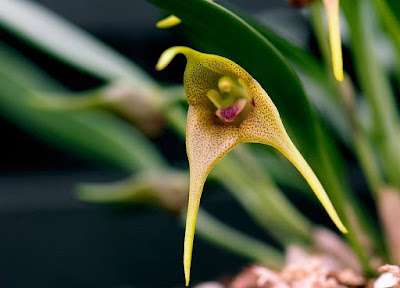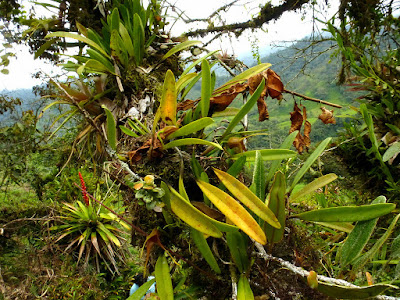Masdevallia peristeria is found in open woodland and along water runs, near to the ground at altitudes of 1500 to 2500 meters in Ecuador and Colombia. Gustav Wallis first collected M. peristeria (although the locality was not given) for Messrs. Veitch, and specimens were sent to Reichenbach for identification. Reichenbach’s publication of this species occurs in The Gardeners’ Chronicle in 1874.
Masdevallia peristeria also called as The Dove-Like Masdevallia, Byrsella peristeria, Masdevallia ellipes, Masdevallia haematisticta, Masdevallia peristeria subsp. haematosticta, is a species of the genus Masdevallia. This species was described by Heinrich Gustav Reichenbach in 1874. It is named for its dove-like petals; peristeria derives from the Greek word for dove or pigeon.
IDENTIFY MASDEVALLIA PERISTERIA ORCHID PLANT
Masdevallia peristeria is found in open woodland and along water runs, near to the ground at altitudes of 1500 to 2500 meters in Ecuador and Colombia. Gustav Wallis first collected M. peristeria (although the locality was not given) for Messrs. Veitch, and specimens were sent to Reichenbach for identification. Reichenbach’s publication of this species occurs in The Gardeners’ Chronicle in 1874.
It is a small sized, cool to cold growing with stout, erect ramicauls enveloped basally by 2 to 3 loose, tubular sheaths carrying a single, apical, linear-lanceolate, suberect, thick, fleshy, obscurely petiolate leaf that gradually narrows below into an indistinct petiole.
The Dove-Like Masdevallia blooms in the spring and summer on a short to 9 cm long, terete, pale green spotted with crimson inflorescence arising from low on the ramicaul, with a loose floral bract holding the single, malodorous flower at mid-leaf. The stiff, waxy, 7.5 to 13 cm flowers have a dovelike shape visible in the column and petals and is held below the leaves. The sepals have a light yellow-tan, bright yellow, or even pinkish background coloration with dark wine-red freckles. The large, wine-red lip is also quite verrucose. This species can also have more than one flowering stem per leaf (not simultaneously), and the flowers last for many weeks.
MASDEVALLIA PERISTERIA ORCHID PLANT CARE AND CULTURE
Cultural information should only be used as a guide, and should be to be adapted to suit you. Your physical location; where you grow your plants, how much time you have to devote to their care, and many other factors, will need to be taken into account. Only then can you decide on the cultural methods that best suit you and your plants.
Light:
Masdevallia peristeria like good light, but not direct light. 17000 - 22000 lux is a good amount of light. About 70-90% shade is recommended in summer and 25% shade to full sun in winter. It will flower better if receive plenty of light and leaves are pale green rather than dark green when in heavy shade.
Temperature:
The Dove-Like Masdevallia like cool growing conditions from 5°C to 25°C. Ideally in winter they like a minimum of 10°C in and a maximum of 13°C. In summer the optimum range is 13 to 20°C. The temperature should not exceed 25°C and temperatures consistently above 30°C will weaken the plants and they may drop their leaves. Ensure 6-12°C day/night difference to aid flower formation.
Humidity:
This orchid prefer high humidity in summer near 75-80% and may need a humidifier over summer. Keep air circulation at all times to prevent water staying on leaves as this will encourage leaf spot.
Substrate, growing media and repotting:
Masdevallia peristeria can be grown in basket or net pots. They can also be grown in pots or mounted. They prefer a continuously damp medium. Some growers use chopped sphagnum moss mixed with polystyrene chips. Others use a pine bark, polystyrene and coarse perlite mix. A mix of 5 parts bark, 5 parts perlite and 1 part fibrous, not fine, peat moss is recommended. Their roots are small and many and will fill pots very quickly when growing well. Deeper pots are generally used and plants are potted out from being divided into 5cm tubes, 7-10cm pots or 12-15cm pots depending on size.
Repot or divide the plants during the autumn or spring every two years or when they are sufficiently large enough. It is best, as with most plants, to repot when the plants are about to root to minimize disturbance. Huge clumps must be divided as a considerable number of species tend to completely rot from the oldest parts of the clump. Do not bury the base of the plants. Double potting is beneficial to keep the plant roots cool.
Watering:
The Dove-Like Masdevallia will not tolerate dry conditions and should be kept moist but not soggy. Their roots must be able to dry out slightly between waterings. In hot weather they need daily watering but in spring and autumn weekly watering should suffice. Water in the morning so leaves can be dry by midday. The plants should be provided with rain water or distilled water or a very pure water source. It is preferable to provide a humid environment than keeping roots too wet as they are prone to rotting.
Fertilizer:
Masdevallia peristeria are generally active throughout the year although growth may be slower in winter. Use a balanced fertiliser at 1/4 strength throughout the year; feed at every third or fourth watering. If in doubt do not feed. These plants do not like salt so roots will easily turn brown if over fed. If plants need a boost then a dilute foliar feed can be applied. Higher feeding schedules can be used if the grower masters their culture perfectly well. Do not use lime or dolomite lime.















COMMENTS